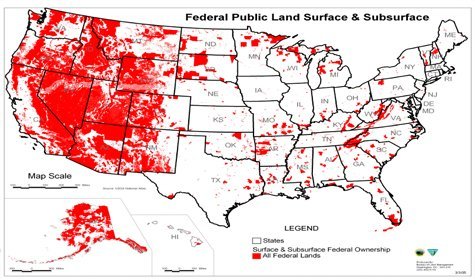With what is currently transpiring in Oregon, it is imperative that we understand the underlying issue that continues to be obscured to the average American. With that in mind we are re-printing the Tenth Amendment Centers 2014 article when the issue was raised during the Arizona incident and the dispute over grazing rights. We hope you find this article informative and helpful.
Federal Land Ownership: Is It Constitutional?
The ongoing Cliven Bundy situation in Nevada has raised awareness of the hazards of federal land management.
In Nevada, the federal government owns a stunning 81 percent of the land. On the land they manage, the feds are threatening to evict tenants who refuse to pay outrageous fees. Bundy is the last of a dying breed, the only holdout who hasn’t been driven off land in Clark County in recent years, land his family has utilized and improved for nearly a century.
This behavior raises and important question: Is this how the Founding Fathers intended for the federal government to manage land when they created the Constitution? A 2005 University of Colorado Law Review article by Robert G. Natelson of the Independence Institute titled “Federal Land Retention and the Constitution’s Property Clause: The Original Understanding” attempts to answer that question by carefully examining the historical record against conservative and liberal interpretations of the Property Clause of the Constitution.
The article begins by talking about the case of a Bozeman, Montana native by the name of Casey Emerson. Emerson wants the feds to cede their land holdings back to the people. He argues that the feds don’t tend to the land as well as local folks could, and make blunders that harm the environment and livelihood of Montana residents. Natelson argues that while Emerson’s opinion doesn’t reflect present case law, there is a strong historical basis for his argument against the excessive hoarding of land by the federal government.
This becomes clear when you examine the core principles that the Republic was based upon. It is widely recognized that the principles of republicanism and decentralization were crucial in founding the United States of America, but there were also some principles that fell by the wayside as time passed. While they aren’t necessarily acknowledged now, they were considered to be essential for the continuance of a well-functioning Republic by our predecessors. These principles are fiduciary government, sympathy and independence.
Fiduciary government refers to the idea of government officials as “guardians, agents, servants, or trustees of the people.” Sympathy meant that public officials and private individuals are meant to share an “identity of interest, rather than conflict of interest.” Government officials are therefore expected to serve the public as a whole rather than serve a specific faction or political party. Independence is necessary to prevent collusion between government actors, to keep them free from each other and dependent only upon the public. Knowing these bedrock principles upon which the Republic was founded is key in understanding the appropriate purpose of federal land management.
Natelson brought up an example to illustrate how these principles weren’t respected during the Articles of Confederation era. In the early Republic, an angry band of former soldiers who felt they weren’t properly compensated stormed Congress. This was when Congress still operated out of Philadelphia, rather than Washington D.C. The Congress didn’t have the means to defend itself. Delegates asked Pennsylvania to send militiamen to help, and the state refused. Although nobody was injured, this incident was harmful to the principle of independence. The founders did not want one state to receive preferential benefits over another. They didn’t want a mob of folks from Pennsylvania intimidating Congress into granting special favors to people of that state at the expense of others.
The Constitution therefore allows the federal government to possess land in three forms: territories, enclaves and other property. Territories referred to land that was owned by the federal government but had not been formally made into states. Enclaves referred to land within a state that was owned by the federal government for essential purposes such as ‘Forts, Magazines, Arsenals, dock-Yards.’ Other property refers to land holdings for enumerated purposes, and gives the federal government limited discretion to possess land.
However, the Constitution does not authorize permanent land-grabs by the federal government. It authorizes Congress to make “all needful Rules and Regulations” pertaining to land. ‘Needful’ was a word carefully chosen to indicate that the regulatory power only expanded to powers specifically enumerated in the Constitution. The feds were expected to sell off non-essential land and distribute the subsequent monies in ways that benefited the public good such as paying off the debt or tax cuts.
The current regime of federal land management is blatantly unconstitutional. The founding fathers never intended to create a Republic where the feds could impose draconian fees on peaceful individuals and force them from the land. As a matter of fact, that is exactly the arrangement that the Constitution was written to prevent, as it clearly violates the principles of fiduciary government, sympathy and independence.
When the historical record is examined, it makes it abundantly clear that the Republic has gone awry since the days of the founders. Systematic attacks on the property rights of Americans have been justified through deliberate misreadings of the Constitution. This will only be changed when the public wakes up, re-discovers their rights and takes action against unjust federal power. Natelson’s article can provide a kick start toward creating a proper understanding of the Constitution amongst the American people.
Federal Land Retention and the Constitution's Property Clause: The Original Understanding


![The Constitutional Authority for State Border Defense and Security [VIDEO]](https://i3.wp.com/austincountynewsonline.com/wp-content/uploads/2024/04/Constitution-Border.jpg?w=440&resize=440,264&ssl=1)
:quality(75)/https://static.texastribune.org/media/files/d1749af8ff9fc79922234d2b56c4c730/0308%20Cruz%20SOTU%20REUTERS%20TT%2001.jpg?w=440&resize=440,264&ssl=1)
:quality(75)/https://static.texastribune.org/media/files/bcbe0c4ad76e3c3a260f645dd3ca9262/EARLY_VOTING_Oct_22_1_MS_TT.jpg?w=440&resize=440,264&ssl=1)
:quality(75)/https://static.texastribune.org/media/files/1c103041aa4278b5f06acb5abafcfe5e/0323%20Border%20El%20Paso%20JH%20REUTERS%20TT%2002.jpg?w=440&resize=440,264&ssl=1)
